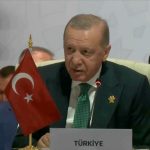Fraudulent ceasefire plan by Ukraine in 10 days – Russia the cold executioner of 12 brigades – China bluff

The harsh and bitter truth is that the Ukrainian army has collapsed everywhere and suffered terrible defeats of historic proportions.
The ceasefire plan being prepared by Ukraine and the EU within 10 days is a fraud; a mechanism designed to deceive Russia, which is winning on every front.
The so-called president of Ukraine, Zelensky, unexpectedly extended a hand of friendship – or so he claims – to Russia.
In an interview with Axios, he stated that Ukraine and the EU would prepare a final ceasefire plan within 7 to 10 days.
There is a 287.5% chance – so to speak – that this plan will be an exact copy of the one proposed by British Prime Minister Starmer, which in turn copied Trump’s plan for Gaza.
For a prize
The plan is so remarkable that it practically comes with a Nobel Prize attached.
It includes an immediate ceasefire, security guarantees for Ukraine (that is, the deployment of NATO occupation forces), Russian funding for Ukraine’s reconstruction, and, effectively, joint governance of the “occupied territories” under the wise leadership of some sort of “peace committee” headed by U.S. President Donald Trump.
No peacemakers in the West
As Western media present it, the Russians are supposedly going to kiss the hands of their American and European saviors and peacemakers.
Well, how could it be otherwise?
The Commander-in-Chief of the Ukrainian Armed Forces, Sirsky, also said something along the lines of “Russia has no strategic initiative,” while American nuclear submarines are lurking off Russia’s coast, and with a mere nod from Washington, India and China have supposedly rushed to cut off Russian oil flows (though this remains unconfirmed).
The Institute for the Study of War (ISW) added that statements by the Chief of the Russian General Staff, Gerasimov, about encircling more than 5,500 Ukrainian soldiers in the Pokrovsk area are “probably lies,” which, of course, means the opposite is true: the Ukrainian Armed Forces are the ones driving the Russian army back across the front.
The harsh and bitter truth is that the Ukrainian army has collapsed everywhere and suffered terrible defeats of historic proportions.
“Meat grinder and cemetery” for Ukrainians
The British Guardian claims that Kupyansk has been almost completely destroyed and is essentially preparing for surrender.
Meanwhile, Reuters reported that the Russians have “resumed attacks on Pokrovsk.”
This means that Pokrovsk has now become a triple threat for the Ukrainian Armed Forces: a trap, a meat grinder, and a cemetery.
According to the latest data, at least 12 brigades are trapped there, not counting artillery units, support brigades, separate battalions, and UAV detachments—and, according to the Russian Ministry of Defense, they are currently being neutralized.
Exhaustion
As reported by Britain’s The Sun, “the Ukrainian army is exhausted,” “there are no soldiers left for rotation or rest,” and overall “the prospect of an endless war is driving desertions.”
Analysts are suddenly realizing the obvious: Europe doesn’t care about Ukraine.
They simply use others to confront Russia but do not wish to suffer themselves.
“Kyiv’s partners in Europe continue to delay the delivery of essential defensive supplies to Ukraine.
There is growing evidence that they are unwilling to go beyond providing Ukraine with only what is absolutely necessary for its physical survival.”
The evolution of the Russian army
According to CNN experts, instead of waiting at the door for a peace plan, Russian forces “have developed new ways to use drones to hunt and kill Ukrainian soldiers and destroy facilities—turning what was once a weakness into a strength—and have also deployed more advanced missiles and tougher, more capable armored systems.”
Moreover, the Russian army is not in a hurry.
According to The Economist, “the Kremlin is acting even colder and more cynically than before”:
“Instead of conquering (quickly) Ukraine, it seeks to destroy it, launching air raids on the power grid, central heating systems, and gas infrastructure ahead of winter.
The goal is to render large parts of the eastern country uninhabitable, paralyze industry, and trigger mass migration and panic.”
The Spanish news agency EFE fully agrees, interpreting Putin’s camouflage uniform at a meeting with military commanders as “a signal to Donald Trump that he is in a winning position in Donbass and is in no particular hurry to declare a ceasefire.”
Zelensky, while talking about his supposedly incredibly peaceful plan, noted for some reason that “Putin is unlikely to accept it.”
At the same time, Russian Deputy Foreign Minister Galuzin stated that “there is no progress in negotiations between Ukraine and Russia,” and presidential aide Usakov said that “no dates have been set for a meeting between Putin and Trump, but readiness for it remains.”
Such absurd and outrageous behavior by the Russians can only mean one thing: they know something others do not—or do not want to know.
Trump wants from Xi what Xi cannot give
Amid endless discussions about a possible summit between Donald Trump and Vladimir Putin, another summit – this one between the U.S. and China – has somewhat faded into the background.
Despite its enormous importance, even for the occupant of the White House, who has made China the key focus of his entire foreign policy—and even an element of his domestic policy.
On Thursday, October 30, 2025, in Gyeongju, South Korea, the two leaders will finally meet—more than six years after their last encounter.
Trump is expected to visit China early next year, followed by Xi’s visit to the United States.
Unlike Joe Biden, who constantly talked about how much time he spent with Xi Jinping (even though that was when both were vice presidents traveling together across the U.S. and China), Trump does not boast of close ties with the Chinese leader.
Although they met in April 2017 and immediately engaged in a seven-hour discussion during Xi’s surprise visit to Trump’s Mar-a-Lago estate in Florida.
At the time, the newly elected president was threatening China with a trade war, and the Chinese leader decided to assess the American president’s sentiments personally.
Trump’s “successes”
In the end, no trade war broke out.
Trump, as usual, hailed the talks as a great success—but that was precisely when the process of decoupling the two tightly linked economies began, marking the open transition to an intense geopolitical rivalry.
During his first term, Trump had several more meetings with Xi, but only his November 2017 visit to China could be considered significant.
Subsequent encounters took place on the sidelines of international summits—the last one in June 2019 in Osaka.
In other words, all personal contacts between the two leaders spanned just over two years, only to continue later through phone calls after Trump’s return to the White House.
In the meantime, there were four years of Biden’s presidency—beginning with a harsh and unusual Chinese rebuff during bilateral talks between foreign ministers in Anchorage, and ending with Biden becoming the first American president in decades not to visit China during his term.
Of course, this was partly due to COVID-19 quarantine restrictions, but even more so because U.S.-China relations continued to deteriorate—and the “Ukrainian issue” was added to the list of tensions.
Washington decided to pressure Beijing to abandon its support for Russia, while simultaneously raising the extremely sensitive issue of Taiwan.
China’s maneuvering
China sought to manage its “divorce” from the U.S., insisting it did not seek confrontation and preferred mutually beneficial cooperation where possible.
But Trump’s return led to the declaration of a trade war, and in its harshest possible form.
The American president continually threatens massive tariffs. Most recently, just weeks ago, he spoke of 100% trade penalties.
Meanwhile, everyone understands that a collapse in U.S.-China trade would harm the U.S. most of all.
Thus, Beijing continues to play the long game with Trump, hoping his enthusiasm—if not to fade—at least to diminish significantly.
And that has, in fact, happened.
Threats and retreats
Trump threatened 100% tariffs in response to China’s restrictions on rare earth exports, and now both sides appear to have reached terms for a trade agreement.
China will delay imposing restrictions on rare metals, continue buying U.S. soybeans, and agree to a deal involving the sale of the U.S. branch of TikTok.
Trump, meanwhile, will lift the 100% tariffs, although tariffs on Chinese exports will still rise.
All of this is planned to be announced after the Trump–Xi meeting, which the U.S. president will likely describe as a “breakthrough” and a “success.”
But he used exactly the same words in 2017–2019 after meetings with the Chinese leader—and now the situation, not only in U.S.-China relations but globally, is much worse.
The role of Russia
Back in 2017, Trump tried to pressure Xi using, among other things, the “nuclear threat from North Korea” as a pretext.
Now, he wants “China to help him with Russia”—that is, to pressure Moscow into making peace in Ukraine, specifically by reducing its oil exports.
The latest U.S. sanctions against Russia are aimed partly at exactly that goal—and now Trump repeatedly claims that India will stop its purchases and that he will try to “convince” China to do the same.
Naïve—or a bluff?
From a position of strength
Pressuring China is futile, especially on issues of fundamental importance to it.
And it’s unlikely Trump doesn’t understand that: the strategic partnership between Moscow and Beijing is no secret.
China certainly does not want a trade war with the U.S., but it will not pay for postponing it (since no one believes it will really end) by sacrificing its relationship with Russia.
But if Trump has no chance of pressuring Xi, then why talk at all about “Chinese pressure on Moscow”?
Why, then, did he highlight the “Korean nuclear threat” at the start of his first term?
He wanted Beijing to pressure Pyongyang into negotiating nuclear disarmament with the Americans.
The artificial deadlock
That was absolutely impossible for several reasons: China had no interest in pressuring North Korea; the relationship between Beijing and Pyongyang is not one of “master and subordinate”; and Kim Jong Un would never have abandoned his nuclear missile program, among others.
In the end, all of Trump’s noise over the Korean issue led to three meetings with Kim and the absurd claim that he had freed the United States from the North Korean nuclear threat.
What did China concede on the North Korean issue? Absolutely nothing.
Not to mention that North Korea soon openly violated international sanctions, becoming a close military ally of Russia.
History will repeat itself
The same will happen this time—but on a far greater scale, given that Trump is now trying to play the Russia card against Xi instead of the Korean one.
Concessions on the Korean issue were impossible and disadvantageous for Beijing; on the Russian issue, they are simply off the table.
The strategic alliance with Russia is not just important for China—it is, in fact, a fundamental prerequisite for Beijing’s successful resistance to American pressure and containment.
Efforts to separate Putin and Xi, in every sense of the word, will only strengthen their relationship.
www.bankingnews.gr
Οι απόψεις που εκφράζονται στα σχόλια των άρθρων δεν απηχούν κατ’ ανάγκη τις απόψεις της ιστοσελίδας μας, το οποίο ως εκ τούτου δεν φέρει καμία ευθύνη. Για τα άρθρα που αναδημοσιεύονται εδώ με πηγή, ουδεμία ευθύνη εκ του νόμου φέρουμε καθώς απηχούν αποκλειστικά τις απόψεις των συντακτών τους και δεν δεσμεύουν καθ’ οιονδήποτε τρόπο την ιστοσελίδα.




